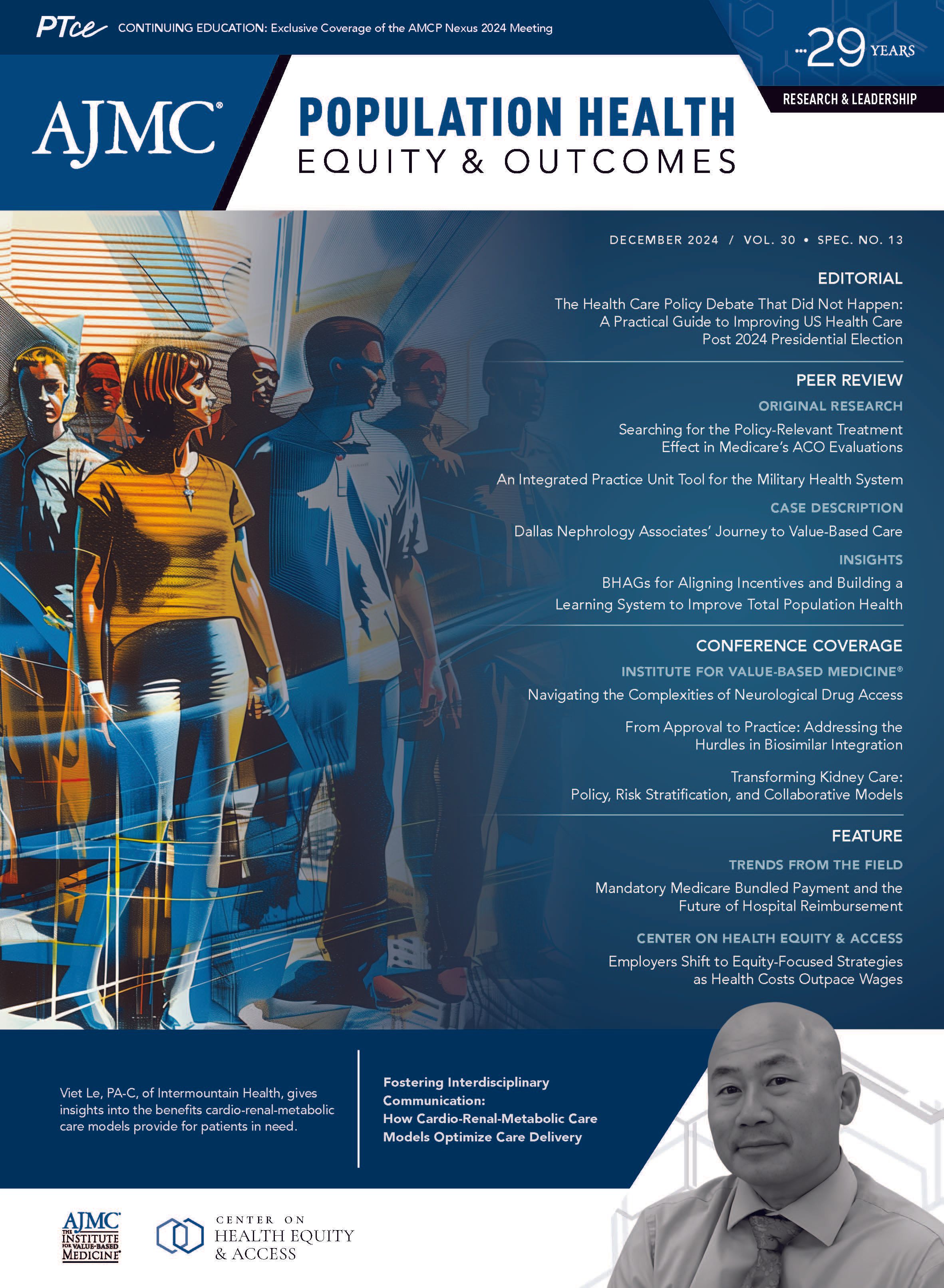Publication
Article
Population Health, Equity & Outcomes
Navigating the Complexities of Neurological Drug Access
Author(s):
At an Institute for Value-Based Medicine® event held in Aurora, Colorado, experts discussed strategies to improve patient outcomes and manage health care costs in neurological diseases.
Am J Manag Care. 2024;30(Spec. No. 13):SP1030-SP1032. https://doi.org/10.37765/ajmc.2024.89650
At an Institute for Value-Based Medicine event held by The American Journal of Managed Care in Aurora, Colorado, on August 22, 2024, event chair Kavita V. Nair, PhD, FAAN, professor in the Department of Neurology and the Center for Pharmaceutical Outcomes Research at the University of Colorado Anschutz Medical Campus, brought together speakers from local organizations to discuss strategies for bridging the gap between payers and providers. Their insights shed light on the need for increased transparency, collaborative decision-making, and a renewed focus on delivering high-value care for patients with neurological conditions.
To kick off the meeting, Nair discussed the "tremendous innovation" that has taken place in the neurology space, starting with multiple sclerosis, over the last 10 years.
This innovation has been "great for patients and providers, but that comes with some complexity as well," Nair said. "We really have to bring stakeholders to the table together to talk about conversation that we're having in our own silos."
Value Frameworks in Rare Neurological Diseases
R. Brett McQueen, PhD, assistant professor at the University of Colorado Skaggs School of Pharmacy and Pharmaceutical Sciences, opened the discussion by highlighting challenges and opportunities in value frameworks, particularly in neurological rare diseases, that have been influenced by recent legislative changes such as the Inflation Reduction Act of 2022, which allows CMS to directly negotiate drug pricing. He also referenced Prescription Drug Affordability Boards (PDABs), which are specific to each state.
“There are limitations on the use of either specific sources of evidence, such as conventional cost-effectiveness or constraints on timelines, making it difficult to have a really robust review of a therapy’s impact on a population,” McQueen said. “There’s also an attention to what we call additional value elements in assessments and guidance from CMS and PDABs. “[It’s] really asking the question, ‘How can patient preferences bridge the gap between payers and providers?’ ”
To address this gap, McQueen and other investigators have been conducting workshops using mixed methods, including focus groups and choice experiments, to prioritize value elements from the perspective of patients with neurological conditions such as spinal muscular atrophy and neuromyelitis optica spectrum disorder (NMOSD).
The framework has also been applied directly in policy decisions with the Colorado PDAB, and a potential 2-step approach was proposed for CMS’ drug price negotiation program to better integrate patient engagement and preferences.
Colorado Medicaid’s Approach to Gene Therapy
Jim Leonard, PharmD, deputy director of the Colorado Department of Health Care Policy and Financing, provided insights into the state’s innovative strategies for addressing the challenges posed by high-cost gene therapies. As these transformative treatments have entered the market, Colorado Medicaid has adapted its management tools to ensure appropriate access for its members, Leonard explained. This included a focus on population analysis to forecast utilization and budget impacts, as well as close collaboration with the University of Colorado’s Center for Pharmaceutical Value research team to better understand treatment duration and potential cost offsets.
Additionally, Leonard discussed the limitations of traditional utilization management tools such as preferred drug lists (PDLs) and drug utilization review, as well as the need for value-based agreements.
“We had a lot of drug classes in common disease states—diabetes, asthma, hypercholesterolemia, etc—where we had multiple drugs utilizing the same mechanism of action, and it fit well into that model,” Leonard said. “However, once you start getting outside of drugs for a disease state that have different mechanisms of action, or you get outside of drugs that work the same way, with the same indications, it gets a little more complicated; but we’re dealing with what we have, right?”
He also provided a list of the world’s most expensive drugs, including eculizumab (Soliris), which costs $409,500 annually, and atidarsagene autotemcel (Lenmeldy), with a onetime cost of $4.25 million. He emphasized the impact of new gene therapies on health care costs and pointed to the importance of population analysis and treatment durability.
“For outcomes, we have to establish a target—a lot of times for us, this is literature based, but it can get creative,” Leonard said. “I think that it’s always interesting to see the real-world evidence vs controlled clinical trials and where we might have a way to gather some of that information as part of our contracting process.”
Transparency and Provider Needs for Higher-Prevalence Diseases
The first panel discussion of the evening provided a deep dive into the challenges faced by both providers and payers in managing the growing number of treatment options. The experts highlighted the treatment evolution in multiple sclerosis, including a variety of injectable, infusion, and oral therapies, as well as those in phase 3 development: tolebrutinib, fenebrutinib, and remibrutinib.
“I think it’s always difficult when you’ve got this mix of orals [and] injectables; it’s really hard to do utilization management between medical claims and pharmacy claims,” Leonard said. “You’re not always able to make sure that the claims are being utilized on both. So that’s one of the pain points for us: How do you manage a PDL class when there are some injectables that you’d really like to be part of that structure as well?”
Additionally, the panelists mentioned recently FDA-approved antiamyloid treatments for Alzheimer disease, including lecanemab (Leqembi) and donanemab (Kisunla). These approvals have been tremendous for patients with mild cognitive impairment, but "it is a limited patient population," noted Katie Coerver, MD, PhD, a neurologist with Rocky Mountain Neurology. She recalled how her office was flooded with calls on the day these drugs were approved with patients with severe Alzheimer disease asking about them.
"Yes, it is very exciting that we have something new to offer," she said. "It is a narrow part of the patient population. I think that we are missing many patients with [these approved drugs]."
Rebecca Lich, PharmD, MBA, senior vice president and pharmacy practice leader at Lockton, representing the commercial payer perspective, explained the difficulties in managing site-of-care decisions and the impact on overall costs, underscoring the need for increased transparency in drug pricing.
“In my industry, we talk about site of care; the patient’s got the right medication, the right quantity, all of that, but can it be administered in a different location [at] a lower price?” Lich said.
Enrique Alvarez, MD, PhD, a professor and neurologist at UCHealth Neurosciences Center, Anschutz Medical Campus, emphasized the desire for providers to better understand the financial implications of their treatment decisions.
“It’s not uncommon for us [to have] a drug that used to have a WAC [wholesale acquisition cost] of $65,000 for a year [and] to see a patient coming in with a $130,000 bill from UCHealth for 1 infusion,” Alvarez said. “Being able to cut $40,000 to $50,000 off that by going somewhere else, I can see that; it makes sense why the decisions are being made.”
Across the panel, there was a clear recognition of the need for enhanced collaboration and communication between payers and providers to ensure patients receive the most appropriate and cost-effective care.
Innovations in Treatments for Rare Neurological Diseases
A second panel then focused on the unique challenges in managing rare neurological conditions such as NMOSD and myasthenia gravis. Jeffrey Bennett, MD, PhD, a professor of neurology at the University of Colorado Anschutz Medical Campus, provided an overview of the treatment landscape, highlighting the recent FDA approvals of several high-cost, infusible therapies, including eculizumab, inebilizumab (Uplizna), satralizumab (Enspryng), and ravulizumab (Ultomiris). He emphasized the importance of early, aggressive intervention to prevent further disability in patients with NMOSD.
In contrast, Thomas Ragole, MD, an assistant professor of neurology at the University of Colorado Anschutz Medical Campus, discussed the more variable treatment approach for myasthenia gravis, where newer targeted therapies have shown promise, but older, less expensive options such as rituximab (Rituxan) still play a role. He noted the lack of robust real-world data to guide optimal treatment sequencing, underscoring the need for continued research and collaboration between providers and payers.
Both panelists acknowledged the significant time and effort required to navigate the prior authorization process for these rare disease treatments, even when Medicaid coverage was ultimately obtained. However, Ragole expressed frustration with the need to jump through hoops to access certain therapies, despite a lack of clear evidence supporting a stepwise approach.
For instance, he said, now there is a questionnaire that providers have to complete for the patient, Ragole said. “[Patients] can’t fill it out. [Lots of clinics, including ours,] have tried to do this, have people fill out this myasthenia gravis activities of daily living [questionnaire]. If patients fill it out, it’s wrong and it’s not validated.… [But] a structured interview is how this thing has to be given.”
Overall, panelists emphasized the importance of value-based contracting, data sharing, and open dialogue among all stakeholders to balance patient access, clinical outcomes, and health care system sustainability.
“I think in our disease [landscape], we still have to go through some of these steps, and there are barriers that sometimes make me bang my head against the wall, but generally, for our practice at the university, it has not been that big of an issue,” Ragole said.
Author Information: Ms Steinzor is an employee of MJH Life Sciences, the parent company of the publisher of Population Health, Equity & Outcomes.

2 Commerce Drive
Suite 100
Cranbury, NJ 08512
© 2025 MJH Life Sciences® and AJMC®.
All rights reserved.




